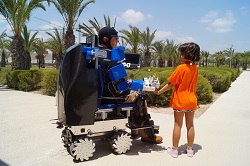Daily chores made easy with the right AIDE
Around 80 million people in the EU, a sixth of its population, have a disability. Accessibility is a basic right for all persons with disabilities according to the United Nations Convention on the Rights of Persons with Disabilities signed by the European Commission in 2010. Enter on stage the AIDE prototype The AIDE project has constructed and tested a fully autonomous prototype including an arm exoskeleton attached to a robotised wheelchair. “The focus was on the development of a totally new shared control paradigm that integrates information from identification of residual abilities, behaviour, emotional state and intentions of the user,” according to Dr Nicolas Garcia Aracil, project coordinator. The modular and adaptive multimodal interface is customisable to the individual needs of people with disabilities. Ultimate in user input for intention The prototype integrates all hardware elements. For processing data from the user regarding intention, there are different options according to the user’s requirements. An unobtrusive and wireless hybrid brain/neural computer interaction, BNCI, system based on an electroencephalograph for brain activity with an electro-oculogram records eye movements. For evaluating and recording the electrical activity produced by skeletal muscles, there is an electromyograph and there is also a voice control system. For context recognition, there are two red, green, blue plus depth (RGB-D) cameras with RGB-D sensors for 3D localisation and eye-tracking glasses for estimation of gaze point and object recognition. High- and low-level control was incorporated to control the robotic exoskeleton or external robotic device, and there is also a communication and entertainment system. The AIDE project has validated the AIDE prototype with 17 end users suffering from various neurological conditions in the Cedar Foundation in the United Kingdom and 2 end-user evaluation sessions using different interfaces at the Campus Bio-Medico University in Rome. Unexpected challenges end in surprise advantages “In the third year of the AIDE project, one of the partners entered into formal liquidation,” says Dr Garcia Aracil. As a result, a project extension of 4 months was requested to mitigate the impact of termination of the liquidated company and the time needed by the new partner Robotnik SLL to become fully operational. Partnering with Robotnik opened up the possibility of incorporating improved features to the system, such as an omnidirectional mobile base for the wheelchair and a laser-based navigation and localisation system. Future commercialisation and customisation Three European companies and a private centre for rehabilitation are writing a proposal to be submitted to H2020-EIC-FTI-2018-2020: Fast Track to Innovation Call to accelerate the market uptake of the innovative arm exoskeleton developed by AIDE. “By using a novel modular multimodal perception system it is possible to customise an adaptive multimodal interface towards disabled people’s needs,” concludes Dr Garcia Aracil.







